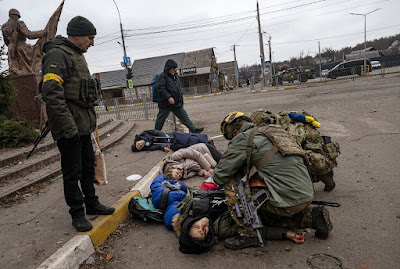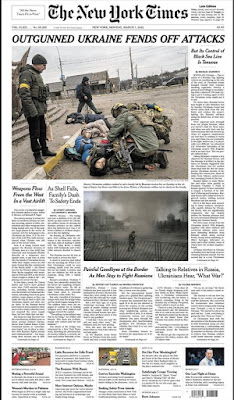Somehow, photography still, in 2022, packs an emotional punch. It is a medium that freezes a moment in time.
The March 7 edition of The New York Times featured a photograph of a mother, her two children and a volunteer who was helping them attempt to flee to safety in Irpin, Ukraine who died in a Russian mortar barrage.
 |
| From NYTimes.com, web site of New York Times, the famous image by Lynsey Addario, published on the paper's front page . |
It’s a stark, dark moment in a stark, dark war. And a reminder of what photography can sometimes do. Think of the emotional punch of the picture of the crying girl over a body at Kent State. Or the fleeting Vietnamese girl, running naked from her village which has just been napalmed.
And now we have Tetiana Perbyinis and her two children, Mykyta and Alisa, teen boy and a young girl, along with a 26-year-old volunteer who had been helping them, dead on the street.
 |
| Image posted on Twitter by New York Times. |
American newspaper editors tend to be more prudish about these things than many of their international counterparts, and I’m OK with that. Images of excessive blood or badly damaged human remains are seen as being too cruel, inflicting pain on the family of victims of violence.
Although, in this case, as a follow-up New York Times story details, the husband would rather that the image be shared so the world knows what the Russian military did, what happened to his loved ones.
The Washington Post had an interesting reflection March 9 on how journalists decide what images are not too awful to publish in cases of stories like this. Paul Farhi reports that Times editors didn’t hesitate with this image, considering it too important to the story that needs to be told.
Well, yes, although one issue with an image like this is that the emotional content brings a deep reaction, but not necessarily a lot of insight. How did this happen? What is the context of this war? When are such civilian deaths merely the accidental outcome of conflict vs. the end goal of a country’s actions? Seeing the image itself doesn’t answer anything, nor does it tell us about Teiana, Mykyta, Alisa nor Anatoly Berezhnyi, the man who died with them.
As war in Ukraine has unfolded, I have not widely sampled all American media. I read AP reports in my local paper, The Gazette. I watch CNN and MSNBC reports at night. I listen to radio news from NPR. I find myself often checking the New York Times web site—via computer and my phone—partly because, as a professor at the college where I teach, the Times is made available to me by my institution.
So I can’t speak in broad terms about how this war is covered. But I can say that I have appreciated the depth of the New York Times efforts to cover this war. Journalism, done well, is so important at a dark hour such as ours now.
Lynsey Addario, the experienced photographer who rushed out to make this heart-wrenching image, fulfilled her role here. She witnessed and recorded. These days, images are often not trusted, but everything surrounding this one suggests it was authentic and honest, not some deep fake.
And horrible. And maybe that’s the point.
The freezing of an instant in time. The snap of a shutter after the crack of a mortar shell. And the world bears witness. Let’s hope that sad emotions aren’t the only response. If war journalism does nothing else, at least it forces all of us to recognize what is going on.
Yes, wars happen all the time. And we should pay attention when the victims of violence aren’t 43-year-old white accountants and computer programmers—tan, black, brown and yellow victims of war are just as human and suffer as much pain. Nor can merely learning about such violence be enough to stop it.
But it won’t be stopped if we don’t learn. Even if we do need the words to get the context, the image is an important part of that learning, creating an indelible memory of a tragic moment in time that should not be forgotten.
No comments:
Post a Comment